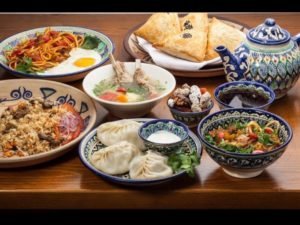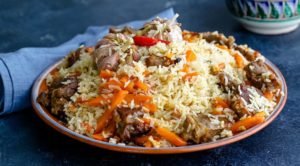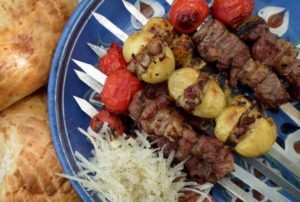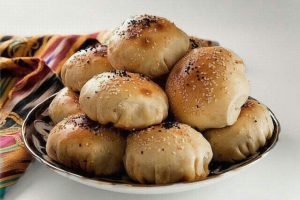UZBEK CUISINE
Uzbek cuisine is the national cuisine of Uzbekistan. Rich cuisine, has a deep history, is closely connected with the Uzbek culture, language and traditions. Significant impact on the diversity and originality of the recipes had the fact that, in contrast to the geographical neighbors, Uzbeks historically characterized both a sedentary lifestyle and a nomadic one. At the same time, culinary traditions and ancestral culture have been preserved, as well as interrelations with neighboring nations have had a profound impact on the diversity and richness of dishes. The origin of many of them has deep roots and has preserved the traditional look. They are popular all over the world, such as plov, lagman, manti and others.
The Uzbek cuisine has established remarkable traditions in the preparation of all kinds of dishes: main meat dishes, soups, bakery and confectionery products, salads and drinks.
The main meat dishes are characterized by the preparation of fried, high-calorie foods, the extensive use of cottonseed oil, sheep fat, oil, spices and greens.
Male professional chefs are called “Oshpaz” (Uzbek. Oshpaz). In a broad sense, oshpaz is generally a cook, but usually in the Uzbek language, this term is understood precisely as a specialist in the preparation of plov.
Uzbek cuisine arose as a result of the coexistence and mixing of several cultures, a long-term development in the region of the Fergana, Tashkent and Samarkand oasis – an important trade crossroad for the whole of Asia. Especially here, the mixture of Persian and Turkic culture, so characteristic of Uzbekistan, that took place in the 10th-12th centuries influenced. This traces the characteristic commonality of the Uzbek and Tajik cuisine. At the same time, there is a serious difference from the cuisine of the nearest geographical neighbors of the nomadic peoples of the Kazakhs, Karakalpaks and Turkmen.
Uzbek cuisine has grown to a large extent on Asian traditions and recipes, but it has its own specifics.
The most popular meat ingredient is lamb, but beef and horse meat are widely used. The main meat dishes are usually cooked with a large release of the product. For example, the classic pilaf recipe is a proportion of 1 part of meat – 1 part of rice. Oil is abundantly used, and cotton oil is very popular, and it is customary to melt it before using it [9]. Classic dishes are not customary to cook very sharp or spicy, but herbs and spices are widely usedsuch as zira (cumin), cumin, barberry, coriander, sesame, dill and basil (rayon). Often, special dairy products such as katyk and suzma are used as a component of salads.
Specific is the use in soups (shurpa) croup – masha (a type of beans), jugary (sorghum), rice, corn. Meat dishes are almost always cooked with onions, and its laying in proportion to meat is much more than in European cuisine. When cooking minced meat for dumplings, the usual recipe is two or three pieces of onion to one part of the meat.
One of the most popular and famous dishes is plov. For Uzbek and Tajik cuisine is characterized by the joint preparation of meat and grain (most often it is rice). In contrast to, for example, Azerbaijani cuisine, where meat and grain are cooked separately. In general, vegetables and cereals are practically not used as a separate dish or side dish, they are included as ingredients in main dishes. Fish and fat poultry are unpopular in Uzbek cuisine. Eggs are limited.
Confectionery and bakery products are also very diverse. The main and one of the most popular bakery products – Uzbek bread (Uzbek. Non) – are divided into two main categories:
- Obi-non (uzb. Obi-non) – on yeast dough and water.
- patyr-non (uzb. patir-non) – on pastry or puff pastry with added oil or fat.
The traditional type of dishes, on which pilaf and many other dishes are served – lagan, a large flat plate or dish. In a modern meal in Uzbek cuisine, forks are rarely used – if plov is not eaten by hand, then it is customary to eat it with a spoon. Other utensils used in Uzbek cuisine are: spit (deep bowl), piyola (usually a cup of tea).




